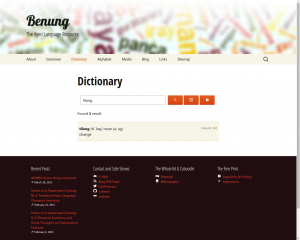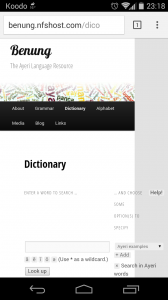The text on the Ayeri website’s landing page (itself an anacronism these days?) with its evocation of strange, fictitious lands where the language is supposed to be spoken has long slightly bothered me, seeing that I haven’t come up with substantial world-building for this long-running conlanging project of mine so far. Thus, I have recently—and rather ad hoc—come up with a new text that is more plain about Ayeri. Just as with the old text, I’ve tried translating it into Ayeri to give a taste right off the bat.
Manisu ya Benung. Bukuno narānena Ayeri! Ang Ayeri narānas manisa (narāntiyanas), sinā le ringyang suyan berdayyena luga pericanjya-ikan. Eng da-lomasāra edanya yām ku-ibangas tiyo, siyā ang ming ajāy narāneri nay sungkoraneri narān. Eng kadāra eda-baloybenung nilanjyas si ang avancon macamley vehanena, linyeley tiyo palung naynay si ang tiyāy ling pericanjya misisānyam neprisānena nay valyanyam sinā tiyayang. Valyu pecamanas eda-baloyyena!

The text goes as follows. I hope it’s in line with the Grammar, since I’m feeling quite out of practice. A thing I noticed is that there’s no way to handle clauses that function as constituents (object clauses, adverbial clauses, etc.) in Ayeri in the same rather elegant and concise way you can do this with ing-participles in English (“[…] working out ever more details of which has served me as a creative outlet for playing with language and linguistics for many years”). I thus had to rephrase the translated text a bit.
- Manisu ya Benung. Bukuno narānena Ayeri!
welcome LOC=Benung storage language-GEN Ayeri
‘Welcome to Benung. The Ayeri Language Resource!’ - Ang Ayeri narānas manisa (narāntiyanas), sinā le ringyang suyan berdayyena luga pericanjya-ikan.
A.AN=Ayeri language-P.AN fictional conlang-P.AN REL.P.AN.GEN P.INAN.TOP=raise=1SG.A amount[TOP] detail-PL-GEN for year-PL-LOC=many
‘Ayeri is a fictional language (a conlang) whose amount of detail I have raised for many years.’ - Eng da-lomasāra edanya yām ku-ibangas tiyo, siyā ang ming ajāy narāneri nay sungkoraneri narān.
A.INAN.TOP=such=serve-HAB-3SG.INAN this[TOP] 1SG.DAT as=field-P.AN creative REL.P.LOC A.AN.TOP=can=play-1SG.TOP language-INS and science-INS language
‘It has thus served me as a creative field where I can play with language and linguistics.’ - Eng kadāra eda-baloybenung nilanjyas si ang avancon macamley vehanena, linyeley tiyo palung naynay si ang tiyāy ling pericanjya misisānyam neprisānena nay valyanyam sinā tiyayang.
A.INAN.TOP=gather-3SG.INAN this=site.web[TOP] thought-PL-P.AN REL A.AN.TOP=document=3PL.AN.N.TOP process-P.INAN construction-GEN thing-PL-P.INAN creative other and.also REL A.AN.TOP=make=1SG.TOP during year-PL-LOC realization-DAT theory-GEN and enjoyment-DAT REL.DAT.GEN create=1SG.A
‘This website gathers thoughts documenting the construction process, and also other creative things I made over the years for the realization of theory and the enjoyment of what I created.’ - Valyu pecamanas eda-baloyyena!
enjoy-IMP browse.through-P.AN this=page-PL-GEN
‘Enjoy browsing through these pages!’
Unfortunately, WordPress’ WYSIWYG editor makes it rather impossible to properly align interlinear glosses in linguistic examples anymore, to my best knowledge. On the other hand, I suppose that this kind of markup is a very special need of very few people (insert Star Trek joke here).
In other news, you can also tentatively follow this blog on the Fediverse at @/blog@/ayeri.de now (remove the slashes after the @ signs), because I wanted to try out Matthias Pfefferle et al.’s cool new ActivityPub plugin (markup beyond basic HTML would likely be gone anyway if viewed through the likes of Mastodon, Firefish, Lemmy, or Kbin). There’ll also be great news about my Ph.D. endeavors coming up soon-ish, I hope. 😀 A blog post giving a glimpse into what I wrote my thesis about that’s hopefully accessible enough for other conlangers as well is already in the pipeline for this occasion.
Incidentally, Ayeri is celebrating its 20th birthday this December, and this realization has just completely caught me by surprise. 😅 Bavesangas mino, I suppose, and briyu-briyu! 🎉🥂


